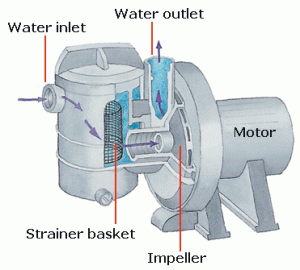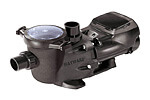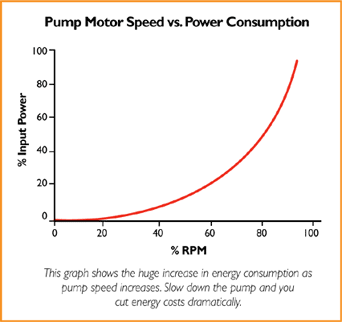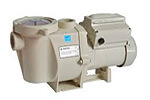FREE Standard Shipping On All Orders $100 or More!*
Choose Your New Pool Pump Wisely
Your new pool pump is an extremely vital piece of equipment; it is the "heart" of your swimming pool. Just as your heart circulates the blood throughout your body, a pool pump circulates the water throughout your pool.
A pool pump consists of an electric motor and wet end assembly. The motor spins an impeller inside an air tight housing which creates suction, to pull water from the pool, and push it through a filter and back to the pool. Pool water needs to be regularly and fully circulated to stay clean and clear. Without a pool pump circulating your pool water, or a filter to remove contaminants, a swimming pool quickly becomes stagnant and unpleasant.

First, water is drawn from the pool through a hose or pipe called the influent line. The influent line leads into the pump where water is passed through a strainer basket and on to the impeller. The impeller, a rotating turbine that is attached to the electric motor shaft, creates centrifugal force as it spins. This centrifugal force, meaning the outward movement of the water caused by the impellers rotation, is what forces water out through the effluent hose or pipe, leading to the filter.
Inground pools require self-priming pumps as the pump usually sits above water level. Priming refers to the pool pump being able to lift water up vertically, from the pool. Conversely, above ground pool pumps are not self-priming. These types of pumps usually sit below the water line; therefore they rely on gravity to prime. In some cases, on aboveground pools, the pump needs to be located above the waterline. In these types of applications, a self-priming (inground) pool pump should be used.
Is Bigger Better?
American's have a V-8 mentality; we like big engines. It's common for pool owners to buy a pump larger than they need, and even some dealers of builders are guilty of being horsepower hogs. Many 2hp pumps have been installed when a 1hp pump could deliver the same flow volume, with greatly reduced energy usage. Larger pumps not only produce larger electrical bills, but having an over-sized pool pump can lead to poor filtration when matched with smaller pool filters.

Luckily, the industry is working its way out of this blind assumption that bigger is better, and sizing pumps accurately has been improving. And now, with the need for efficiency in our energy poor states, Two-Speed pumps have becom more popular and Variable Speed pumps were developed, to provide even greater energy savings. Many states have now mandated that new or replacement pumps over 1 HP must be either two speed or variable speed. California, Arizona, Florida and Texas have such laws already, and by 2021 Variable Speed Pumps will be required in every state in the U.S..
A single speed pump is going to run at one speed (3400 rpm) every time it's on, until it is off. A two-speed will have the option to run at a high or low speed. A great advantage to these is that when you are vacuuming or skimming, the pump can be running at a high speed and once that is completed you can revert down to the low speed.
Is it Horsepower, or RPM's?
Larger horsepower pumps "draw more amps" - and that's what you really pay for on your electric bill, Amperes. If you can reduce the size of the horsepower on a replacement pump, you will definitely see savings. This can be accomplished by using a High Head pump, or a pump that produces more water volume. For instance, a 1hp Whisperflo pump will produce the same flow rate as a 2hp Superpump, at a greatly reduced amperage requirement.
Variable speed pumps are a bit different. They are definitely High Head pumps, but have the ability to control the RPM's of the motor. But variable speed pumps aren't sold by horsepower - that's because they are All horsepower, and they dial in the amount of horses needed, to produce the lowest amount of motor revolutions, to get the job done.

As the chart shows, reducing the speed at which the motor turns, saves an almost equal amount of electricity. Variable speed pumps are configured to your pool's specific needs, and therefore will offer the most energy savings. Most variable speed pumps offer pre-set speeds, or are fully programmable, allowing you to select the rpm of the motor. Slow the Flow ~ and you reduce the amperage draw or power to run the pump. Speeds can be as low as 400 rpm, to a full 3450 rpm, capable of flow rates equal to a 3hp Whisperflo pump - if needed, for water features or spa jets, for example.
With two speed and variable speed pumps you will see a higher initial investment, but in energy savings alone you can recoup that money in a short time. Payback, in electrical savings, can be in as little as 2 seasons. Variable speed pumps also have the added benefit of being extremely quiet, cool running, and the unique motor design is built for a long-life of outdoor, continuous duty.
If you need to meet the new pool pump law requirements in your state, or just want to save hundreds on your energy bill, look to the full rated, energy efficient Whisperflo pump. Compare the flow charts of your existing pump with the Whisperflo chart (look in the Owner's Manual), and buy a smaller horsepower. Or, install a 2 speed pump and you can operate high speed for just a few hours per day, then low-speed (1/8hp) for 12-18 hours daily. If you really want to save the most money, and you already are using a big pump, look to the variable speed pumps by Pentair or Hayward.

If you are not looking to improve energy consumption and are satisfied with your pump's performance, then there is nothing wrong with getting an exact replacement. This option will usually be the easiest installation since you will not have to move plumbing around. Just don't be tempted to "drop-in a V-8" when it comes time to replace the pump. Bigger is not Better when it comes to pool pumps!
Thank you for taking the time to learn more about pool pumps and why they are so important to your pool.Whether you are looking for Standard, 2-Speed or Variable Speed pool pumps, we have them here at In The Swim. For questions on sizing a pool pump, or just much more info about pool pump selection - see this post aptly titled "What's the Best Pool Pump?".